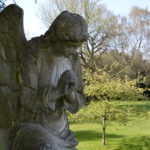Funeral Policy
Churchyard Regulations
The Churchyard at Holy Trinity has been closed for burials since 1899, but interments of cremated remains (ashes) are still permitted. All parishioners, non-parishioners whose names appear on the Church Electoral Roll, and non-residents who die in the parish, have a legal right to interment of ashes in the churchyard. For other non-parishioners, the permission of the Vicar and Churchwardens is required. The fee for the interment of ashes of a non-parishioner may be higher than that for a parishioner.
1. Procedure for the Introduction of Memorials
Permission must be obtained for the introduction of any memorial. Horizontal ledger stones (to commemorate the interment of cremated remains) may be authorised by the Vicar in accordance with the terms and conditions given below; but other types of memorial including sculpture and crosses, must be authorised by the Chancellor under faculty. Applications for specially designed and appropriate memorials will be sympathetically considered by the Chancellor.
Every application to place anything whatsoever or to do any works in the churchyard must be made in writing to the Vicar, in the first instance, using the appropriate Diocese of Oxford Application Form. Written permission must be obtained from the Vicar before accepting an estimate or otherwise entering into a contract with a funeral director, stonemason or craftsman.
2. Dimensions of Ledger Stones
Ledger stones must be laid flat so that the upper surface is flush with the ground. The standard size for a ledger stone is 360mm by 260mm, portrait.
3. Materials
All memorials must be made of natural stone with non-reflecting finish.
A ledger stone is not permitted if it is black, blue, red or green (or appears to be any of these colours) or is otherwise brightly coloured. The use of marble, synthetic stone or plastic and painted surfaces is not permitted.
4. Designs
Ledger stones may not take the form of a statue or a particular object such as a heart, a person, animal or other figure and photographs, porcelain portraits or glass shades are not permitted.
5. Epitaphs
Inscriptions must be simple and reverent, and may include felicitous quotations from literary sources provided they are not contrary to the doctrine of the Church of England. Inscriptions must be incised, or in relief. Plastic or other inserted lettering is not permitted. Additions to an inscription at a later date, following a subsequent interment in the same grave or for other suitable reason, are permitted but must be authorised by the vicar and the lettering, lay-out and wording must be consistent with the original inscription.
6. Flowers
Cut flowers in an unbreakable, removable container, wreaths and potted plants may be placed on graves, but they must be removed as soon as they appear to be withered. No artificial flowers are allowed except for Remembrance Day poppies and traditional Christmas wreaths, and these should be removed after period of not more than one month.
7. Churchyard Maintenance
It is greatly appreciated when relatives care for graves for which they have a responsibility, but in order to facilitate mowing and the general care of the churchyard the following points must be observed:-
(i) No kerbs, railings, fences or any other edging markers are permitted.
(ii) No stone or glass chippings are allowed.
(iii) The use of glass or other breakable containers for cut flowers is highly undesirable.
Faded flowers and dead pot plants are likely to be removed as part of churchyard maintenance.
Memorials remain the property of the person or persons responsible for their installation, who are responsible for their maintenance.
These regulations are based on those issued by the Diocese of Oxford (effective from 1st January 2017) and have been adopted for local use by the Parochial Church Council.
January 2022

